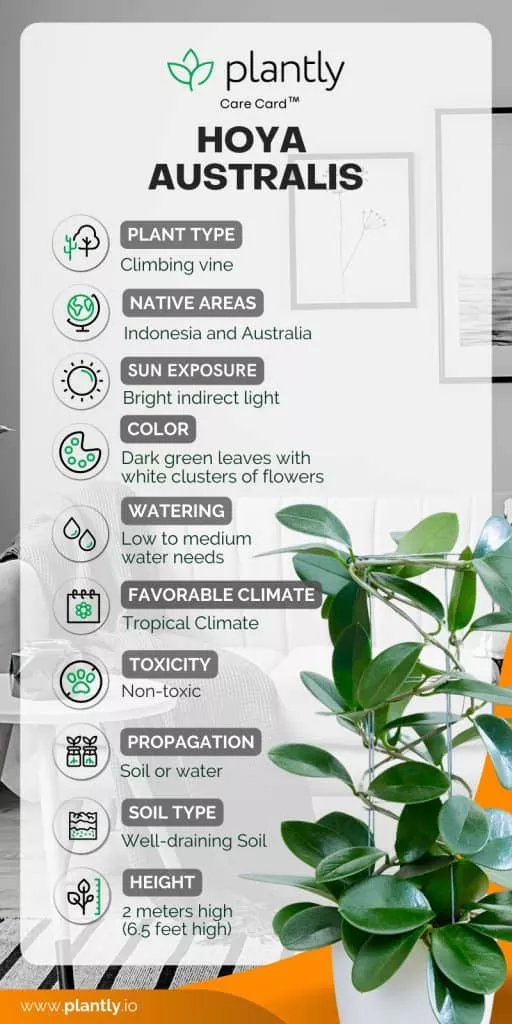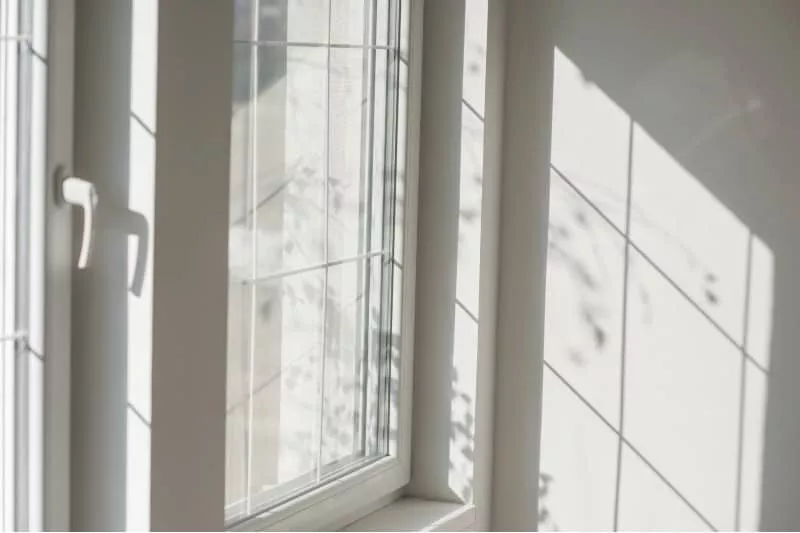No products in the cart.
Table of Contents
The Hoya australis attracts butterflies with its beautiful flowers grown in the garden. But, the good news is that this plant grows well indoors. So, go ahead and add it to your houseplant collection.
The good news! The Hoya is easy to care for. It has attractive foliage with sweet-scented wax white flowers. In addition, it has a cerise inner marking found under the white corona.
Each flower has a five-pointed star shape, and the cluster of flowers in itself looks like a star. Thus, many growers refer to it as the waxvine.
So how do you care for this tropical plant? You stay a while longer to find out all you need to know here.
Hoya Australis Plant Introduction

The Hoya australis is an interesting plant found in Indonesia and Australia. It belongs to the Apocynaceae family and grows long lengths if not trimmed.
Some other common names are the Porcelain Flower, Waxvine, and Honey plant. You find the waxy flowers growing in late winter, lasting through summer. The smell can be overpowering.
Growers noticed the Australis for the first time in 1770. They found the plant on the Australian northeastern coast. You can find over 200 different species, with seven belonging to Australia.
To find out more on how to care for the Waxvine, make sure to keep reading.

Hoya Australis Care

Now that you have seen the beautiful flowers of the Waxvine, do you want one? That is good news, as the Hoya Australis care guide here will help you. Your plant grows fast and loves to climb up to two meters (6.5 feet) high.
Caring for the plant is easy, and the best part it comes with air-purifying qualities.
Best Potting Mix
Hoya plants love a mixture of well-drained soil to grow. First, choose a soil medium providing the Australis with an epiphytic condition to grow. Next, the potting mix needs to drain well to prevent root rot.
You can make a mixture using one part orchid bark, one part peat-free compost, and one part coarse perlite. Yet, if you plant your Australis in cactus compost or a succulent potting mix, amend it with:
- pine bark,
- charcoal,
- or perlite.
Doing this provides enough drainage to prevent overwatering your plant. The recommended level of pH ranges from 6.1 to 7.5 when it comes to Hoya Australis care. So, the soil is acidic to neutral.
Now, if you grow them in a greenhouse, choose a loam-based equal-part mix of sand, bark, and leaf mold.
Watering Needs
Another important thing with Hoya australis care is when it comes to watering. The Hoya plant has succulent leaves that store water and, on average, need watering every ten days only. Overwatering your plant can lead to root rot and cause it to die.
Observe the soil with a moisture meter or use your finger. The upper half of the potting needs to dry out before watering. During summer, keep the soil moist but not waterlogged. Then, you can give it a good watering and allow the water to drain through the drainage holes.
We recommend using filtered or rainwater if the tap water is heavy with chemicals. During winter, water your hoya plants sparingly. Another sign of overwatering is when the leaves turn yellow or fall off.
For underwater, the leaves become crisp and would need a generous drink. Once you water it, the leaves turn back to dark green. As it is an epiphytic plant, it can go for a couple of days without water.
Necessary Lighting

Hoya australis is an outdoor plant by nature and is a vining plant that can climb trees. It needs bright indirect light for new growth. It enjoys the early morning or late afternoon sun to produce its white flowers. Hoya plants thrive in full sun to partial shade due to their waxy leaves.
If treated as an indoor plant, it’s best to keep it a few feet away from a sunny window. If the light is lacking, you may also supplement it with artificial light.
Temperature & Humidity
Your wax plant is a happy chappy indoors with temperatures between 65°F to 70°F (18°C-24°C.)
Always keep an eye on drafts as they can disturb the growth of your Hoya australis. Your plant can handle temperatures in winter between 55°F to 60°F (13°C-15°C.)
If grown outdoors when the temperature gets cold at night, it’s best to bring your plant indoors.

Your wax plant grows well in tropical or subtropical climates, but it needs high humidity levels grown indoors. Still, it can withstand low levels of humidity within the 40% to 60% range. Great, but how do I do this?
You can place it on a container with clay granules, and gravel or use recycled materials. Keep the gravel moist lower than the pebbles, or use a humidifier.
Fertilizer Requirement
You can use an all-purpose fertilizer during the growing season. Your plant is not a heavy feeder. Take a ¼ teaspoon of the feed and mix it with a gallon of water. A good fertilizer is a balanced one such as 15-15-15 or a 7-9-5 blooming one.
During winter, your plant needs no feeding at all. The recommendation is to feed your Hoya plant from spring to fall.
Do you plan to use commercial plant nutrition to encourage growth in your Hoya plants? Dilute one teaspoon (5ml) of it per gallon (liter) of water. You can spray it or mist it over the foliage.

You can use a high-potassium liquid feed diluted in half to initiate flowering.
Plant Propagation
The best way to expand your Hoya australis collection is through stem-cutting propagation. You can do this using water or soil. Here we provide you with guides using both techniques.
Stem Cuttings in Water
- Choose a healthy cutting with two nodes (where the leaves appear and new growth will occur.)
- Fill your container with distilled water and add some rooting hormone at least two drops.
- Place your stem cutting in the water by submerging the nodes.
- Waist for two weeks to see the root buds growing.
- Once the new roots reach a couple of inches, you can repot your cutting in well-drained soil.
Stem Cutting Propagation Using Soil
- As with the water method, select a healthy cutting without a flower with at least two nodes.
- Mix three parts perlite with one part coco peat or peat moss. Plant your cutting in the potting mix.
- Place a plastic bag over the pot to keep in the humidity and heat.
- You will notice new roots growing within a month. Once the new roots appear, remove the plastic cover and proceed with care as normal. To help boost growth, you can use a rooting hormone as well.
Growth Zone

You can grow your Hoya australis outdoors when you live in the USDA hardiness zone 10 to 11. But please do check our recommended lighting and care Hoya australis tips mentioned.
Potting Your Hoya Plant
Your hoya plant enjoys remaining root-bound. Only transplant your Hoya australis if needed to prevent disturbing the roots. Choose a pot with enough drainage holes and mix porous soil with pumice or perlite.
To help maintain a healthy system, we recommend using a terracotta pot. The best time to repot is during springtime.
Hoya australis flowering
When does your Australis hoya bloom? Flowers will start appearing in summer. Once your plant flowers, you will notice a sweet fragrance like chocolate or vanilla.

You notice star-shaped clusters with red spots at the base of the petal while the coronas are reddish/purple. Further, the stems have dark green leaves that can grow up to 6cm (2.35 inches) in length.
When grown in sunnier areas, the leaves are yellowish/green. In shaded areas, they’re dark green. Train your Hoya australis when grown in containers. You can use trellises on fences or verandas to help the stems vine.
As your Hoya plant is vining foliage, it can reach vast heights. So, it helps to prune it back and support it to keep maintain its bushy appearance. But, do not over-prune as it can slow down the flowering.
Hoya Australis Varieties and Similar Plants
When it comes to the Australis Hoya varieties, it depends on the subspecies you have. The majority of species of Hoya curl around a shelf or trellis to keep reaching new lengths. Here are some other cultivars available:
Hoya Australis Tricolor
This is another vining Hoya native to Australia. It has oval waxy leaves with colors green, pink, and white leaves. You can expect it to flower up to three times a year, depending on where it grows.
Hoya Australis Tenuipes
Has glossy round leaves with thinner stems compared to most other Hoyas. As a result, you will need to water it more than your Australis, and it also gets clusters of white flowers with a red center.
Hoya australis ssp
Australis Brookfield has white-colored buds that are bigger than the Hoya Tenuipes. The growth is bronze color with golden veins
Hoya Australis Diseases & Pests
Here are some common problems you can find in your Hoyas:
- A common houseplant pest is a mealybug, and your plants are vulnerable to it. To prevent this from happening, keep your plant clean of dead leaves.
- Whiteflies are another insect you can find in these species. The insect causes the leaves to be yellow and die. You will find the pest on the underside of the leaves and can tree it using Neem oil.
- Slugs and snails are other pests creating concerns for your wax plant. You can spread coffee grounds around your plant to keep it protected.
- Yellowing leaves are also a concern caused by cold temperatures.
- Leaf-drop, blackening leaves, or dieback stems can be due to poorly drained soil or cold.
- Poorly drained soil can also cause root rot, and the best is to take cuttings and use the propagation method to save your plant.
Frequently Asked Questions
Your Hoya Australis is a natural climber even without help. It wraps around one another to help it stand up straight. Compared to other Hoyas, the Australis is less of a trailer. We recommend providing it with a trellis for added help.
Your Hoya Australis blooms in the growing season from late winter to summer. But if your Australis does not flower, we recommend adjusting its light conditions.
Move your wax plants to a bright window to expose them to more daylight. With a bit more sun exposure, it helps your Hoya australis develop those gorgeous star-shaped blooms.
Yes, Hoya australis is generally considered an easy plant to grow. It is a hardy and low-maintenance species, making it suitable for beginners. With proper care, it can thrive in a variety of conditions, including indoor environments.
Yes, Hoya australis can be propagated from a leaf alone. Cut the leaves using a clean knife, and stick it to a moist soil situated under bright indirect light. In 6 to 8 weeks you’ll see roots growing from the leaves when you removed them to transplant. But Hoya species is typically propagated through stem cuttings, which have a higher success rate for root development.
Whether you want to buy, sell or simply reach out to other plant enthusiasts, Plantly is the right place to be!


